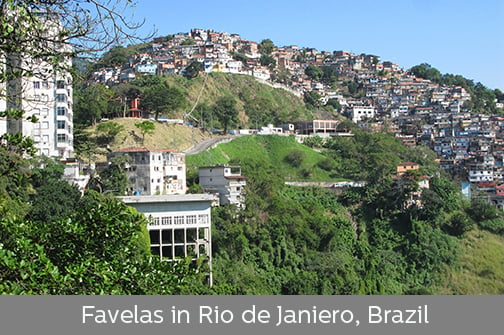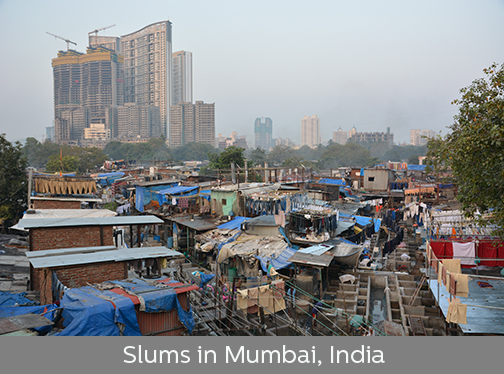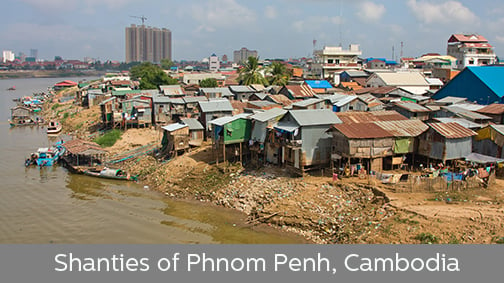By Kirstie Hostetter
Sustainability Analyst Intern
Sustainable Investment Group (SIG)
 In January 2016, I attended the 12th Annual International Conference on Environmental, Cultural, Economic & Social Sustainability in Portland, Oregon. One of the most thought-provoking sessions I participated in was a series of speakers from around the world who spoke to the challenges of building livable, urban spaces. Many cities around the world suffer from haphazard development patterns that have left certain communities isolated from the rest of the city: the precariously perched favelas lining the mountains that encircle Rio de Janeiro, the patchwork slums following the power lines that lead out of Mumbai, the narrow walkways that wind their way through the shanties of Phnom Penh. These sprawling, makeshift communities are often separated from the resources and facilities such as schools, hospitals, and food stores that help increase people’s quality of life.
In January 2016, I attended the 12th Annual International Conference on Environmental, Cultural, Economic & Social Sustainability in Portland, Oregon. One of the most thought-provoking sessions I participated in was a series of speakers from around the world who spoke to the challenges of building livable, urban spaces. Many cities around the world suffer from haphazard development patterns that have left certain communities isolated from the rest of the city: the precariously perched favelas lining the mountains that encircle Rio de Janeiro, the patchwork slums following the power lines that lead out of Mumbai, the narrow walkways that wind their way through the shanties of Phnom Penh. These sprawling, makeshift communities are often separated from the resources and facilities such as schools, hospitals, and food stores that help increase people’s quality of life.
As I considered these distant places and the challenge of creating spaces that foster a happy, healthy, and sustainable lifestyle, my thoughts drifted to the building design processes I have been exposed to since working as a sustainability analyst at Sustainable Investment Group (SIG).
 Within the standard design process, certain groups of professionals come to mind as helping to turn ideas and concepts for built spaces into the physical buildings where people work, live, and play. At the beginning, the architects create the sketches, then pass those along to the mechanical and civil engineers who decide how to turn the drawings into a reality. Later the interior designers and landscape architects come in to make the spaces beautiful and functional, and the contractor finalizes the project at the end.
Within the standard design process, certain groups of professionals come to mind as helping to turn ideas and concepts for built spaces into the physical buildings where people work, live, and play. At the beginning, the architects create the sketches, then pass those along to the mechanical and civil engineers who decide how to turn the drawings into a reality. Later the interior designers and landscape architects come in to make the spaces beautiful and functional, and the contractor finalizes the project at the end.
Designing a building for LEED certification under the Building Design and Construction standard adds other professionals to the discussion table, including ecologists or consulting companies such as ours. Some of the LEED credits I have worked on while at SIG pertain to a building’s development density, community connectivity, and public transportation access. Buildings can earn points for being located in previously-developed and dense urban areas, for being within a ½ mile walking distance of a variety of basic services, or for being connected to public transportation networks.
With respect to these credits, if a building is located in a poorly planned area even the best design teams and LEED experts cannot obtain these credits. Here another type of professional must be added to the building design process – the urban planner. Those who design the communities where buildings are located hold the key to creating sustainable urban environments.
Urban planners enhance their cities by creating networks of infrastructure and developments that encourage environmental, social, and economic integrity. When people can access schools, work places, grocery stores, shops, and restaurants by using alternative transportation, citizens benefit from reduced air pollution and a stronger sense of shared community. When construction projects utilize previously developed and connected urban spaces, those who build the space benefit from less money spent bringing materials, resources, and utilities into the area.
 Though the favelas of Rio de Janeiro, the slums of Mumbai, and the shanties of Phnom Penh may one day be composed of sturdily designed buildings and homes, it is these buildings’ connectivity to the larger realm of city infrastructure that will determine quality of life for the people who live there and the overall sustainability of these communities. Urban planners knowledgeable in what gives each city its unique character and lifestyle will be essential in designing sustainable cities across the globe.
Though the favelas of Rio de Janeiro, the slums of Mumbai, and the shanties of Phnom Penh may one day be composed of sturdily designed buildings and homes, it is these buildings’ connectivity to the larger realm of city infrastructure that will determine quality of life for the people who live there and the overall sustainability of these communities. Urban planners knowledgeable in what gives each city its unique character and lifestyle will be essential in designing sustainable cities across the globe.
© 2016 Sustainable Investment Group (SIG). All Rights Reserved.



